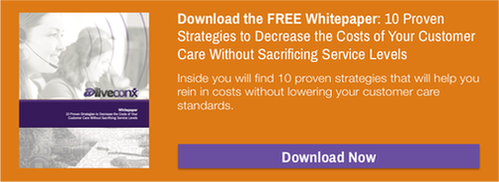Walk the Line: Lower Costs Through Great Customer Service
The effective contact centre will keep costs low with a balance of essential technology and quality customer service.
Does great customer service come at a cost? Building a customer experience isn’t easy, after all. Quality customer service often requires an investment of time, energy, and revenue. At what point do the costs outweigh the reward?
One of the goals of your contact centre is customer retention and protecting existing revenue streams. To accomplish this, your call centre must balance the cost efficiency of its service with the quality of your outreach—too far in either direction may result in disaster for your performance benchmarks, service quality, and overall revenue.
Cost Per Call
When viewed only by the numbers, cost per call is a KPI that measures the overall expense of each customer interaction and can be one of the best metrics for assessing call centre efficiency.
Cost per call is calculated by picking a defined time period (day, week, month, etc.) and assessing what operational costs accrue during that time. Once you know the overall budget for your defined time period, all that’s left is dividing the time period cost by your total number of customer touchpoints. This will give you your cost per call metric.
Once you’ve established your current cost per call rate, you can begin taking steps towards reducing it.
Effective Training
First and foremost, reducing your cost per call rates requires a capable team of agents.
Well-trained agents are essential for quality service. Agents who have received specific feedback and consistent coaching can deliver a customer experience far beyond what new employees can usually manage. These veterans are a valuable resource for your centre—the training process can be long and costly, requiring a large investment of time and manpower.
A more cost-effective way of improving your service is to leverage the skills of your veteran agents. Cross-training them in multiple areas makes your workforce more adaptable to the diverse needs of your market. This flexibility will improve every aspect of your service, from customer loyalty to improved KPIs. This increased loyalty can translate into big savings as well—research by Emmet Murphy and Mark Murphy compiled via Fonolo showed that a 2 percent increase in customer retention had the same effect as decreasing costs by 10 percent.
With your experienced employees handling the bulk of your call volume, you’ll see reduced handle times, better first contact resolution, and lowered cost per call metrics across the board.
Integrated Systems
Integrated call centre software is another great way to boost your productivity and enable the success of your agents. This software should collect data from every touchpoint and compile it into a comprehensive customer profile that can be accessed whenever necessary.
This eliminates the need for agents to search through dozens of platforms and interactions to find old chat logs or account information, allowing for a faster service experience and more personalized interaction. Faster handle times generally correlate with a lower cost per call score, and service personalization will ensure that you don’t sacrifice the customer experience for speed.
Tools of the Trade
Aside from the benefits of integration, data by Cisco showed that cost per call could be reduced by as much as 35 percent by better utilizing call centre software.
How does it work?
Call centre software tools are ideal for improving flexibility without reducing service quality. Let’s take a look at a few examples of how call centre technology can help balance customer service and cost per call reduction:
- Call monitoring tools offer continual re-assessment of performance, allowing agents to learn from their mistakes and enhance the quality of the service they provide.
- Skill-based call routing tools direct specific customers to the agents best equipped to handle their issues, resulting in lower handle times and reduced cost per call.
- IVR software and self-service options for customer support can help manage queue overflow and give callers options to problem solve without occupying your agents. The Real Self-Service Economy Report revealed that 70 percent of consumers expect a website to have a self-service application these days.
Striking a Balance
Lowering your cost per call (and overall call centre efficiency) is a simple matter of finding the right blend of procedural efficiency and service quality.
Faster handle times seem like an easy fix for untenable cost per call scores, but decreasing your service quality to improve company benchmarks may hurt you in the long run. Make sure your centre is adequately staffed with knowledgeable agents who have access to software tools that enable their success. When your centre finds a balance between quality of service and operational efficiency, lower costs will come on their own.
Curious about more ways to decrease your operational costs in the contact centre? Check out our free white paper!










